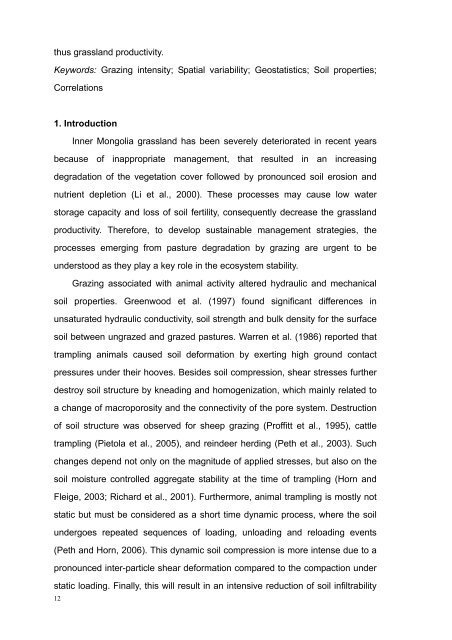SCHRIFTENREIHE Institut für Pflanzenernährung und Bodenkunde ...
SCHRIFTENREIHE Institut für Pflanzenernährung und Bodenkunde ...
SCHRIFTENREIHE Institut für Pflanzenernährung und Bodenkunde ...
You also want an ePaper? Increase the reach of your titles
YUMPU automatically turns print PDFs into web optimized ePapers that Google loves.
thus grassland productivity.<br />
Keywords: Grazing intensity; Spatial variability; Geostatistics; Soil properties;<br />
Correlations<br />
1. Introduction<br />
12<br />
Inner Mongolia grassland has been severely deteriorated in recent years<br />
because of inappropriate management, that resulted in an increasing<br />
degradation of the vegetation cover followed by pronounced soil erosion and<br />
nutrient depletion (Li et al., 2000). These processes may cause low water<br />
storage capacity and loss of soil fertility, consequently decrease the grassland<br />
productivity. Therefore, to develop sustainable management strategies, the<br />
processes emerging from pasture degradation by grazing are urgent to be<br />
<strong>und</strong>erstood as they play a key role in the ecosystem stability.<br />
Grazing associated with animal activity altered hydraulic and mechanical<br />
soil properties. Greenwood et al. (1997) fo<strong>und</strong> significant differences in<br />
unsaturated hydraulic conductivity, soil strength and bulk density for the surface<br />
soil between ungrazed and grazed pastures. Warren et al. (1986) reported that<br />
trampling animals caused soil deformation by exerting high gro<strong>und</strong> contact<br />
pressures <strong>und</strong>er their hooves. Besides soil compression, shear stresses further<br />
destroy soil structure by kneading and homogenization, which mainly related to<br />
a change of macroporosity and the connectivity of the pore system. Destruction<br />
of soil structure was observed for sheep grazing (Proffitt et al., 1995), cattle<br />
trampling (Pietola et al., 2005), and reindeer herding (Peth et al., 2003). Such<br />
changes depend not only on the magnitude of applied stresses, but also on the<br />
soil moisture controlled aggregate stability at the time of trampling (Horn and<br />
Fleige, 2003; Richard et al., 2001). Furthermore, animal trampling is mostly not<br />
static but must be considered as a short time dynamic process, where the soil<br />
<strong>und</strong>ergoes repeated sequences of loading, unloading and reloading events<br />
(Peth and Horn, 2006). This dynamic soil compression is more intense due to a<br />
pronounced inter-particle shear deformation compared to the compaction <strong>und</strong>er<br />
static loading. Finally, this will result in an intensive reduction of soil infiltrability


